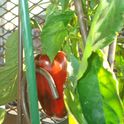I translated an Indonesian recipe into English. What do you think about my translation?
The recipe is "Dendeng Balado Padang (Padangnese Spicy Dried Beef)". Dendeng is a thinly sliced dried meat in Indonesian & Malay cuisine -it's preserved through a mixture of sugar and spices and dried through the frying process. Could you help us to leave your comment and suggestion to my translation?
Serves: 6
Prep time: 45 minutes
Cooking time: 100 minutes
Total: 145 minutes
Ingredients:
400 g silverside beef
8 kaffir lime leaves, remove the midrib
2 Indonesian bay leaves (Or you can use ordinary bay leaf)
1 stalk lemongrass, use the white part
1 tsp salt
1 tsp sugar
1 tbsp tamarind water
50 ml olive oil, to sauté
Palm oil, for deep frying
Blended Spices:
8 shallots
10 red chili peppers
Note: To make the tamarind water, boil the dried tamarind over medium heat about 30 minutes. Strain and discard the solids. Use the water for the ingredient.
Methods:
1. Slice the silverside along with the grain.
2. Put it onto unoiled pan. Cook in the oven to medium temperature (150℃) for about 40 minutes until dried.
3. Put it out and let it cool for 15 minutes.
4. Heat the palm oil, and deep fry it until its super crispy. Set aside.
5. Heat the olive oil, sauté the blended spices, kaffir lime leaves, Indonesian bay leaves, and white part of lemongrass until it smells aromatic.
6. Add the dried beef, salt, and sugar. Mix it well.
7. Pour the tamarind water. Stir it well. Padangnese Spicy Dried Beef is ready to serve.
You can serve the Padangnese Spicy Dried Beef with warm rice.
7 Comments
I highly suggest you consider a descriptive set of photos to accompany your recipe. With the available of current technology (like today's smartphones), this is not a tall order.
Anyhow, good luck.
Exactly what is meant by "the blended spices"? First, I wouldn't refer to shallots and chili peppers as spices. If you mean that they should have been put in the blender or food processor to form a paste, it's best to list that as a step. If they should be chopped or minces, that should be listed as a step.
I think kaffir lime is ok, as it's the common culinary term for a botanical ingredient (which is still fairly exotic here, or at least not a common grocery-store item). People will ask, "can I sub kaffir lime leaves for Makrut?" :)
It sounds delicious.
How much dried tamarind to use, boiled in how much water?
How thin to slice meat? Strips, slices, etc. (Not sure what 'silverside beef' is; Google says bottom round/rump roast - is that what you mean?)
Instead of 'blended spices,' might be clearer to simply list those ingredients and add a step between 4&5: 'finely mince shallots and chili peppers, and mix together well' OR 'finely chop shallots together with chili peppers in a food processor.' Then in the next step, say to add this mixture with the kaffir lime leaves, bay, etc.
Lemongrass - should it be minced? Sliced thin?
In the last 2 steps, do you need to simmer the ingredients (salt, sugar, tamarind water, beef) together for a minute or two, or just stir them in and serve immediately?
Btw, interesting what Maedl says about the term "kaffir" being negative. In the US, "Kaffir lime leaves" is how I've always seen them listed in SE Asian recipes...not sure how else to identify them to be readily understood.
You might also want to suggest an oil to sub for palm oil, if not available everywhere. Peanut oil maybe? (Though it wouldn't have the same color.)
Most US readers panic when metric measurements are used, so I would use pound instead if gram, cups or tablespoons instead of millimeters, and Fahrenheit temps instead of Centigrade. If you are aiming for a British audience, you are safe with metric measurements.
Mention in your head note that the tamarind water needs to be prepared first in order to make the beef.
Anthropologist friends tell me that 'kaffir' is a pejorative word and should not be used. Apparently colonial settlers applied the word in a nasty sense toward the local people, That still leaves the question of what to call these leaves and I do mot have an answer, so I am not sure how constructive this particular comment is. Also, instead of "remove the midrib" from the leaf, I would say 'remove the vein that runs through the leaf's center.'
How thinly should the beef be sliced? In step 4, are you frying the meat? As written, this is not clear.
I would not call shallots and chili peppers spices. Perhaps omit the line "Blended spices" and just list them as ingredients. And do you really want to blend them in a blender, or do you want them chopped very finely? By blending, this sounds like you want a puree, and I don't think that is what you really want.
Is Padang a geographical region? You might explain that.
Silverside beef is not a common term in the US. Are you using something like brisket?
My Thai friend disagrees with your opinion of the word kaffir. Her mother who lives in Thailand also respectfully disagrees.
And as to kaffir, I am telling you what I have experienced. Maybe Thailand was not subject to the same historical developments. From what I have learned, the word was used by Moslems who settled in Asia-- possibly Indonesia.



